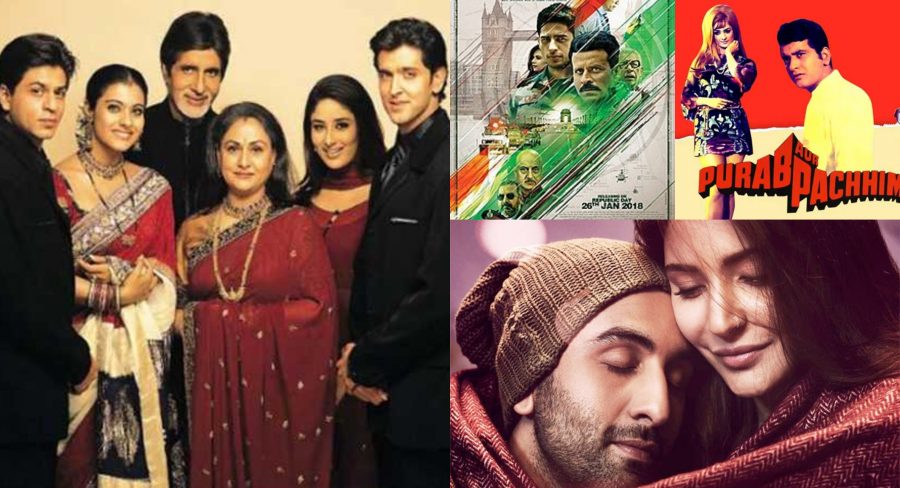Hyper-nationalism to a celebration of capitalist values, and back again – Bollywood films seem conflicted in their representation of the Indian diaspora
Vikramaditya Motwane’s Bhavesh Joshi has a scene where the eponymous character, Bhavesh (Priyansh Painyuli) delivers an intense monologue in exasperation when his best friend, who is soon to leave for the US on a high-paying job, mocks his social responsibility. “This country stinks. Nothing works here; everything reeks of corruption. Now you will fly abroad, and live happily ever after. But I am going to stay here, and strive to make this a better place,” says Bhavesh, not trying to hide the bitterness in his tone.
This blunt honesty is one of the elements that turns Bhavesh Joshi into a niche film that refuses to paint a rosy picture of the system. Also, inadvertently, this scene addresses a popular trope that Bollywood employed in the 90s and the first decade of the new millennium. Post 1991, when India opened its gate to globalization, a new crop of films emerged in Bollywood, one of the world’s largest film industries. These films, directed by the likes of Yash Chopra, changed the way the Indian audience looked at the Indian diaspora across the world by portraying them as model Indians, countering another kind (Purab Aur Pashchim) that showed NRIs in a negative light. Migration to the West had become common then, and films that appealed to the fast-growing diaspora became a necessity for the film industry. Hence, Bollywood started setting films around characters who were sophisticated, opulent and happy, cut off from the third-world problems that continued to plague India, while also being superior to the Indians back home in matters such as sanskar and patriotism. Leaving the country for a richer first-world country (never the Middle-East or South East Asia where there is a considerable Indian presence) became a matter of pride and success in Bollywood.
For one, Teena in Kuch Kuch Hota Hai (1998), despite having a degree from Oxford University and a cosmopolitan upbringing, sings Jai Jagdeesh Hare in perfect rhythm and melody, better than any of her Indian-bred classmates. Anjali in Kabhie Khushi Kabhie Gham (2001) sheds tears of joy and pride on hearing her son sing Jana Gana Mana in a thick American accent, with a bunch of white classmates. It was crudely melodramatic, and yet, one of the defining scenes in the film.
In Dilwale Dulhania Le Jayenge, Amrish Puri is an Indian immigrant running a grocery store in London. He is conservative and a stern patriot who could cry at the mention of ‘apne desh ki mitti’, and his daughter, Simran (Kajol), a second generation NRI woman who has no memories of living in India, is shown to be sanskari, whose only ambition in life is to marry an ideal man. She is a perfectly docile daughter who would not step out of the house without her father’s nod.
Women in these films are the flag-bearers of Indian culture. Teena, Anjali and Simran are smart and educated, but not careerist or rebellious. They do karwa chauth more religiously and impressively than the women who live in India, and they firmly believe in the institution of marriage, and would do anything to keep the family happy. After she meets her future husband in college, Teena embraces ethnic clothes, and gladly switches to the life of a homemaker. Anjali, despite being insulted, ill-treated and mercilessly snubbed by her wealthier in-laws, starts her day in London praying in front of their photographs. Simran falls in love with Raj, another second generation NRI, but both of them wouldn’t marry until their respective families approve of their relationship.
Subhash Ghai’s Pardes (Foreign Land, 1997) takes this further ahead, right from its title song which says there is no better nation than India, to the portrayal of its heroine who vehemently hits back at her fiance, an Indian-American, who ridicules her ‘sanskar’ (Indian traditional values). In Namastay London (2007), a quintessential Indian patriot from small town Punjab, weds a second generation NRI girl from London. He makes her see that no matter how hard she tries, she will only be identified as an Indian in a Western country. In his dream song sequence, she is with him in his Punjabi village, happily adopting the rural Indian life, making round rotis and coyly flirting with him in lush sugarcane fields.
These diaspora films – colourful, entertaining and aspirational in nature – were successful inside and outside the country. In Kabhie Khushi Kabhie Gham, Karan Johar presents the British capital city as an extension of upper-class India where the creamy layer of Hindus can easily feel at home. When his father, Yash (Bachchan), who resides in Delhi, asks his youngest son Rohan (Hrithik Roshan) why he wants to go to London to pursue his higher education, he says in a tone so emotional that words choke in his throat, about how studying in London is a part of his family tradition. And, even though the lead characters are based in London, there are references to India strewn all over the film.
Interestingly, fifteen years later, Karan Johar made Ae Dil Hai Mushkil about two young people living in London, and this time, the air is different. The only references to India are in the scenes where the protagonists celebrate their shared love for vintage Bollywood. Alizeh (Anushka Sharma), Ayan (Ranbir Kapoor) and Sabah (Aishwarya Rai) are metrosexuals who are not bound by nationalist-patriotic emotions.
This change in Johar’s approach to portraying diaspora Indians is an extension of a general trend that turned the patriotic film trope on its head. In Karan’s production Kal Ho Na Ho, which is touted as India’s first multiplex blockbuster, the protagonists are well-settled in liberal Canada, and in a song sequence, they spoof the high-on-patriotism song “Baar Baar Haan” from Lagaan while renovating an Indian restaurant and mocking their arch-rival, a Chinese eatery. In films such as Zindagi Na Milegi Dobara, Rockstar, Love Aajkal, Befikre and Jab Harry Met Sejal, characters are rich NRI youngsters enjoying the fruits of a global economy. In Befikre, the girl is a permanent resident of France, while the boy is a recent migrant from India, looking for a permanent resident status in Europe. They are not moved by patriotism or concerned about traditional values, and the filmmakers use this trope as an excuse to show some exotic landscapes and carefree liberal lifestyle one cannot imagine in India. In films such as Queen and English Vinglish, a trip to the West or the world beyond the national borders liberates the coy Indian woman, and helps her find herself.
Recommended
In the last few years, there is a steady surge in the number of Bollywood films that directly talk about one’s commitment towards the country (Toilet Ek Prem Katha, Aiyaari etc), and films about nationalism and national heroes (Baaghi 2, Rustom etc). Barring a few brilliant exceptions like Court and Newton that talk about moral and ethical degradation of the pillars of the state, and Masaan that refuses to say all is good in a typical ‘peaceful’ Indian small-town where caste-related issues are constantly swept under the carpet, Bollywood has largely conformed to the idea of monolithic nationalism. When it wants to break away from it, the stories and characters seem to move to the exotic West.
*****



